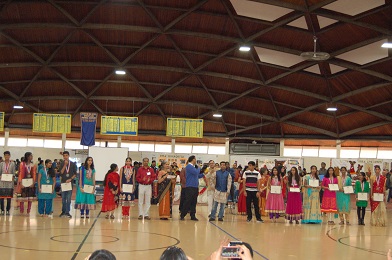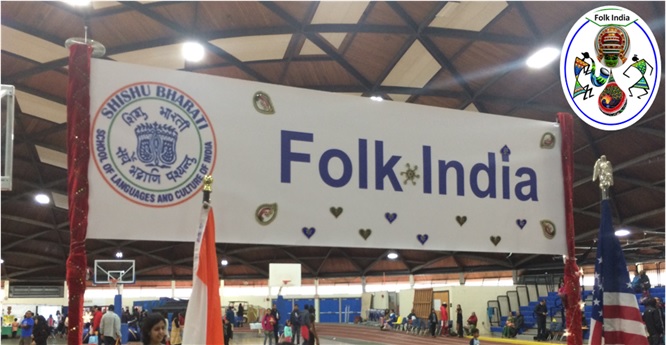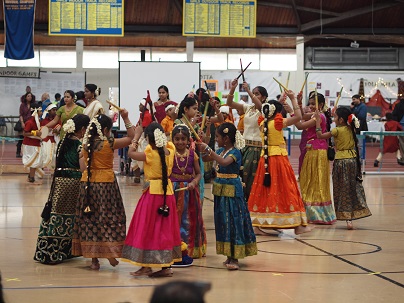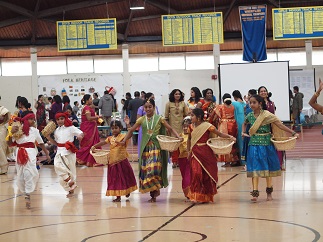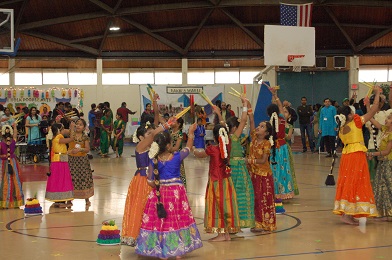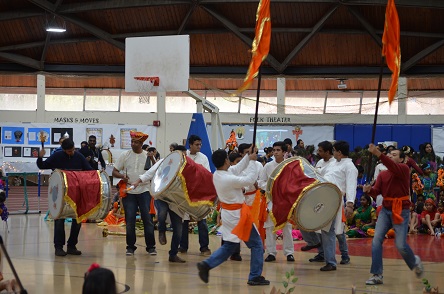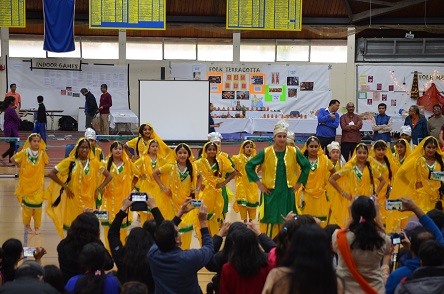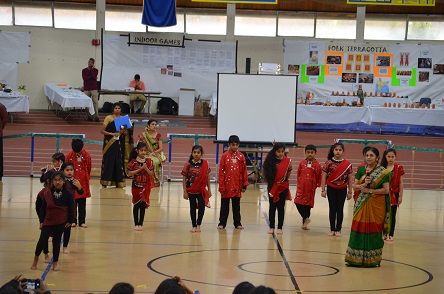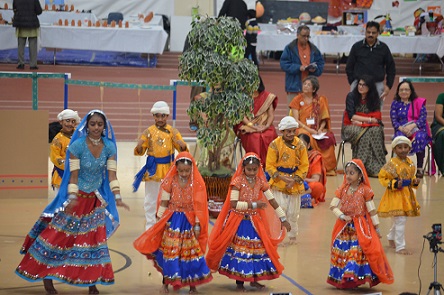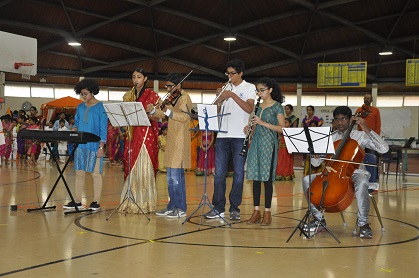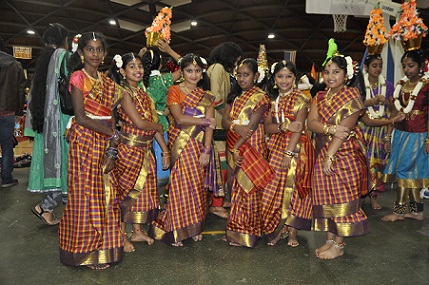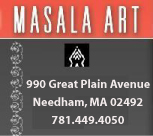Contribute
| Folk India: A Day For Celebrating Indian Culture |
Akanksha Nagarkar and Janani Gandhi
01/04/2017
(This article is sponsored by Masala Art)
Shishu Bharati is a nonprofit organization committed to teaching Indian culture and languages for the past 38 years with many dedicated and passionate volunteers. The school acts as a bridge between the cultures of America and India to several hundreds of our students. We have developed a well-informed cultural pride in our students by creating an environment that fosters learning of Indian arts, customs, languages, religions, history, geography and current events. We have several language programs in Gujarati, Hindi, Kannada, Marathi, Sanskrit, Tamil and Telugu for our kindergarten to 8th grade students. Shishu Bharati serves the community at three centers located in Lexington, Nashua and Walpole. For more information please visit our website www.shishubharati.net.
Mahatma Gandhi said, “A nation's culture resides in the hearts and in the soul of its people”.
Folk Culture is the intersection of people and life itself. It is a dynamic representation of both the modern and rural traditions practiced by the people. This year, we the people of Shishu Bharati decided to celebrate FOLK INDIA to educate our students with the knowledge of our Indian history, origin and culture.
Folk India was celebrated on November 20th 2016, at the Lexington High School, and was organized by Lexington, Nashua and Walpole SB community. The Folk India celebrations were planned by our special event coordinators; Anuradha Balasubramanian (Team Lead), Prajata Lothe, Sanjay Rao and Savitha Narayanan. The program was packed with an array of very exciting and colorful events that included folk dance performances and folk-themed booths.
The celebration started at 9:30 am when our Student’s Alumni Band performed the American and Indian National Anthems, truly representing the diverse spirit of the event. Our President, Seshi Sompuram, welcomed all the attendees, thanked all the volunteers of the SB community for their dedication and compassion to teach hundreds of students to “Perceive, Preserve, and Promote” Indian Heritage. He also applauded our students for their passion to learn Indian culture and languages. Our secretary, Sandhya Nadkarni acknowledged all the event organizers and the entire program was hosted by Ms. Balasubramanian.
We had seven folk dances performed by our students, which includes three dance assortments namely, Maharashtra Medley, Tamil Miscellany & Kolattam / Bathukamma blend from Andhra Pradesh. Plus, we had four more specific folk performances such as, Lambadi from Telangana, Koli from Maharashtra, Bhangra from Punjab & a tribal dance from Nagaland. We invited all the dance choreographers and the students to stage their performances. The dance choreographers introduced their team and described the salient features of each performance. Colorful costumes and various special dance properties and accessories were the highlights of these folk performances.
1. Maharashtra Medley performance started with the warakari - dindi dance procession in praise of God Vitthal, followed by fugadi, kombda, belan dances, dahi-handi and Lezim procession with live music
2. Bhangra, the most popular seasonal dance from Punjab based on the history of Sikhism
3. Tribal folk dance of the Zeliang tribe of Nagaland was a synchronized group performance that involved complex leg movements and simple hand movements with erect postures
4. Lambadi dance of Banjaras of Telangana had a natural rhythm that gave the performance a colorful exposition of joy during festivities
5. Koli dance from Maharastra was a celebration of the fishermen offering prayers to the sea to have a safe fishing season
6. Bathukamma/ Kolattam, the stick dance performed in celebration of Goddess Maha Gauri, was a cultural blend of Telugu speaking and Tamil speaking communities from Andhra Pradesh and Telangana
7. Tamil Miscellany was a dance collection from Tamil Nadu performed at festivities even during the ancient Sangam period (400BCE - 200CE). Mayilattam, Karagattam, Kummi and Parai dance were performed as a Thanksgiving to the Lord for a prosperous harvest season
Both the performers and the audience had a lot of fun. One of the performing student said, “I had a lot of fun! I really liked wearing the costumes! And I got to learn something too!”
The President's Volunteer Service Award (PVSA) is a prestigious award that recognizes dedicated service by individuals or groups. Last year, Shishu Bharati became a certified organization that has been granted authority to verify the volunteer hours required to earn the award. Shishu Bharati always encourages our alumini student volunteers to serve our community. For the year 2105 – 2016, thirty Alumini student volunteers received the award, as an appreciation for more than 50 hours of their service to SB community. The award comes with national recognition and appreciation from the President of United States of America. The Award includes a Personalized Certificate of Achievement, the Official President’s Volunteer Service Award Medallion and a Congratulatory letter from the President Barack Obama.
During the Folk India celebration, we honored and applauded our Alumini student volunteers who received this prestigious President’s Volunteer Service Awards. Student volunteer coordinators from the respective SB campuses introduced their award winners.
We acknowledged sixteen Lexington recipients namely, Gati Aher, Kripa Anand, Soumya Atnoor, Soham Dave, Sakshi Gera, Harini Mohan, Varshini Mohankumar, Prem Patel, Tanvi Patel, Ruhi Patil, Medha Purushotham, Anushka Rathi, Sanjana Sankar, Savni Sarolkar, Nitya Sompuram and Khushal Potdukhe; eleven Nashua recipients namely, Tanya Singh, Rishika Yadav, Dhruv Miglani, Amol Khanna, Aayush Mehta, Avinash Amin, Komal Pandit, Sanjitha Subramaniam, Rajvi Parikh, Ajay Kancherlapalli and Suhani Bhagat; and three Walpole recipients namely, Ashwin Sreevatsa, Amulya Jaladu and Ritika Reevori.
Shishu Bharati principals, Sipra Shah (Lexington), Jay Pandit (Nashua) and Renu Tewarie (Walpole) thanked the students, teachers, parents, and the SB volunteers for their commitment to our community; the booth coordinators and dance choreographers for their continuous support during the Folk India celebration.
The rest of the event, from 11:00 am – 1:00 pm, featured interactive booths that offered glimpses into Indian folk culture. Students, parents and guests visited these “folk activity booths” set up by students, teachers and parents at Shishu Bharati. We had opened 14 booths which portrayed the rich Indian folk culture in the fields of arts, crafts, drawings, paintings, pottery, home décor, costumes, jewelry, food, home medicine, board games, outdoor sports, palm reading, folk dancing, folk musical instruments, tribal masks, folklore puppets and toys used in storytelling and folk theaters ……. You name it, we had it!! Children loved them all, as there were plenty of hands-on activities, giveaways and make-your-own collections.
At these interactive booths, attendees were able to sample herbal remedies, learn about Indian interior design and fashion, play traditional games such as Pallanguli (the Indian version of mancala), and watch reenactments of old plays. “We wrote our own play based on stories from the Ramayana. But we added our own modern spin. People loved it!” said a seventh grade student from the theatre booth. The highlights of the booths were the folk themed displays, live and interactive sessions by the booth coordinators and the hands-on activities for the visitors with the help of volunteers.
1. Arts and crafts – Rakhi & Warli - Warli Painting is a tribal art mostly done by Adivasis in India. Children made Greeting cards using Warli painting. Rakshabandhan is a festival where sisters affectionately tie Rakhi's to their brothers. Using varieties of crafts material visitors made Rakhis. Rakhis are bracelets that sisters tie to brothers’ wrists during the Hindu festival Rakshabandhan. Warli paintings are a traditional tribal art form done in parts of Northern India.
2. Costumes – A colorful assortment of regional clothing, cosmetics, accessories including jewelry and ornamental bags were displayed. The booth had traditional Indian attire from various parts of India. The visitors were given an "instant makeover". Children were welcomed to tryout turbans and pose for pictures and selfies too!
3. Décor – An array of decor items that give a festive look to all the rooms of your home were on display. A variety of materials like beads, gems, wood etc., were used to make these decorative items. Children made bow and arrows, paper lanterns, bookmarks out of Popsicle sticks and paper. There was also a small tent set up which was decorated with traditional Indian decor. Families could go inside the tent and take photos of them-selves inside it.
4. Doodle arts – This booth was set up by our Kindergarten teachers and students. The booth was decorated with projects that kindergarteners had created during this academic year. Younger students were invited to visit the booth and color, paint, and decorate some “folk doodle arts.”
5. Heritage – They had exotic folk drinks from different parts of India, grandma's home remedies and artworks on jute bags and pottery. Handicrafts like diyas and handbags were on display. They also featured “Grandma’s Home Remedies” recipe book and some home medicines were also exhibited.
6. Indoor games – Indoor games, an essential part of childhood in India, were developed over millennia to test the hand to eye coordination, patience as well as intelligence of the players. Four games, Aadu pulli attam (Tigers and goats), Gutte (Five stones), Pallanguli (The original Mancala), Pachisi (Twenty-five) were presented to the visitors to test their skills against our team of volunteers.
7. Masks and Moves – This booth featured tribal masks created by seventh grade culture students. Various tribal masks, musical instruments, and dance properties and accessories which were used in many folk performances were on display. Children and adults learnt a variety of folk dance moves and danced to tunes when their photos were taken as memento.
8. Mela - This booth featured different types of bangles from India. The arrays of bangles were made of glass, gold, silk, beads, and more. Visitors made their own bangles out of play-dough and beads. Paranthys, earrings, headgear, mustache styles wer also on display. They even had a palm reading session.
9. Outdoor games – This booth demonstrated folk outdoor games like bambarum, kancha, paandi, kabbadi, silambattam and more. There were tops and hopscotch for children to play at the station. Children came with lot of energy to watch, learn and play these games.
10. Paper crafts – This booth was a place for children to create paper crafts like origami butterflies, 3D peacocks, and tissue paper decorations. There were diverse take-a-ways you can make your own.
11. Paintings – Indian Folk art paintings are pictorial depiction of Hindu deities, daily village life and nature, which are done on the walls, floors and doors. Visitors copied the Maharashtran Warli and Biharian Madhubani styles of art onto bookmarks and paper flowers. Madhubani art is line based and often depicts scenes in nature. There were also paper rangolis for children to color in.
12. Tales - For this booth, our first grade culture students created dioramas and projects of Panchatantra, “folk tales.” The booth had seven displays to show seven different Panchatantra tales, all with their own morals.
13. Terracotta – Visitors were invited to come and paint designs on clay pots and diyas and they had various terracotta horses and pottery pieces on display.
14. Theater - Indian folk theater has evolved over many centuries in every region of India. Its own unique style is influenced by the regional languages, history & legends. Some of the plays demonstrated in this booth were Ram Lila, Kathakali, Chauu and Kathputli. Visitors were informed on how each style is unique, beautiful and why these art forms have survived the test of time. The booth also taught the visitors about how theater was used as a media source designed to spread news from village to village.
As always, we concluded our celebration with take-home sweet boxes. Overall, the Folk India day had a great turnout and all participants as well as visitors enjoyed the entire event. Our student volunteers, Akanksha Nagarkar and Janani Gandhi interviewed many attendees of the event to compile this report on Folk India.
The success of the event is duly credited to the incredible teamwork of our parents, students, teachers, booth coordinators, dance choreographers, SB committee members, Lexington high school custodians and all the volunteers who shouldered in to synchronize all the aspects of the event.
The “Folk India” celebrations will be remembered as proud and fun filled event in the history of Shishu Bharati.
You may also access this article through our web-site http://www.lokvani.com/
